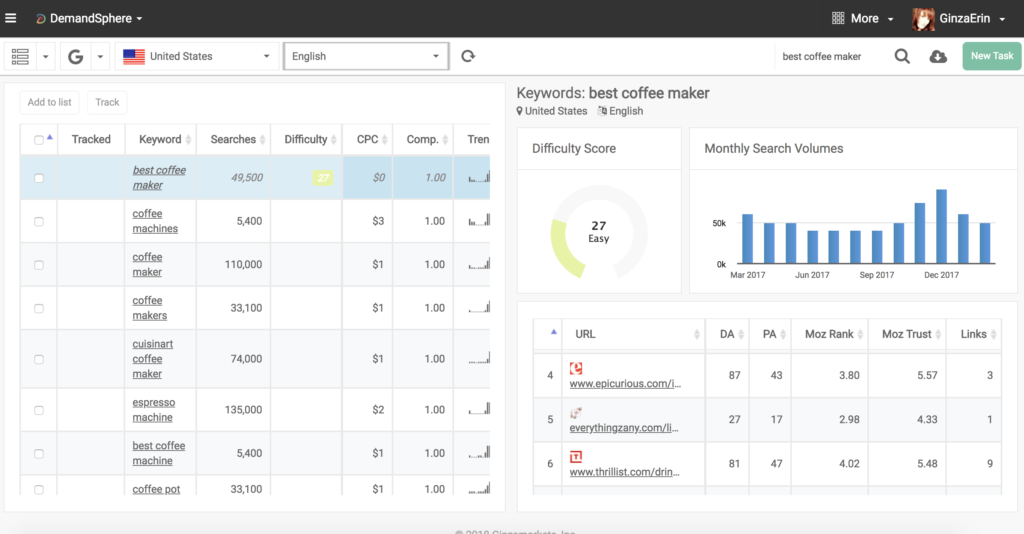Get found with better content and smart SEO writing
With 83.6 million new blog posts read by 409 million people every month on WordPress alone, content consumption continues to grow. Whether it’s via blog posts, social media, white papers, case studies or videos, marketers are focused on getting in front of target audiences. Content is the cornerstone of your online presence.
Writing well for search is not just about search engines and organic rankings. It’s also about relevance across all marketing methods. What does that mean?
Search engines reward (with positive rankings) the most relevant content to an audience. Relevance is a factor of what consumers expect to see and how they interact with the content once they’re there. Things like bounce rate are indicators that content isn’t meeting expectations.
If you’re relevant in search, you’re also more likely to perform well in things like email and social. That’s because you’re already creating the content that people want – and we can leverage that to make your marketing better.
The latest in SEO and content
Search is a link between you and your consumer, whether you’re actively optimizing or not. One constant with search is that it is always evolving. Last year, Google made several major updates to its search algorithm. In 2018, there have already been a few major updates with more certain to come. (The last round of major changes rolled out about a month ago.) With this in mind, we need to regularly revisit our SEO writing practices and our content strategy as a whole.
It can be difficult to stay on top of the changes, and they present an added challenge to SEO writing. The good news is most of the changes are evolutionary, rather than revolutionary. This means you don’t have to regularly make radical changes to your content development process. Periodically revisiting your process will ensure you’re creating content that performs well.
Keep on top this year with our tips for good SEO writing below.
1. Develop a list of topics and content calendar
Most things benefit from a solid plan. Not just any plan though, a plan that uses data and research to fuel decisions. Understanding your audience is key to creating your topic list and content calendar. We recommend a segmented approach, which provides focus for your efforts. Segments are created as part of groups, that belong to categories such as:
- Campaigns
- Messages
- Products
- Features
- Benefits
- Solutions
- And more
For each of these groups, there are segments that can have their own calendars or sections within a principal calendar.
Here’s an example of possible categories with segments:

Developing a content calendar this way not only lets you focus your topics, but also gives you a good measurement system to analyze performance.
You content calendar may focus on on several segments at once, or you may choose to do one segment per week or month. This depends on your resources, the campaigns you’re running, locations you’re targeting, and more.
2. Keywords (still) matter
As much as search changes over the years, some things remain consistent. One of them: Keywords matter. Developing content around carefully selected keywords is still a crucial component of SEO writing.
Once you’ve got your list of categories and segments, you can start to take your topics and conduct keyword research. We recommend choosing three to five keywords for each segment and ensuring you’re creating content that maps back to those.
Below are some important considerations for keywords.
Keyword research
Spend time researching your keywords. Picking the right keyword for each piece of content you create is essential to creating content that ranks well. There are many tools available that show you monthly search volume and provide a difficulty score.

When you’re conducting keyword research, you should look at a combination of search volume, competition, and difficulty. Beyond that though, are a few additional things that you should consider:
- Universal search elements on the page – Are there elements such as ads, knowledge panel, video, shopping results, local pack, etc. that are going to push down your high ranking content? Even if you rank number one for a keyword search, you may still be halfway down the page.
- Type of competing content – What kind of content is already ranking? Is it videos, long form posts, image-heavy? Knowing what the audience already seems to gravitate toward helps you devise a strategy to get on top, or to avoid specific keywords in favor of others.
Building keyword authority
I advocate a strategy that builds authority from the bottom, up. Which means that you select keywords that are less difficult and more specific, or long-tail, to start. By generating content around these keywords, you make it easier to rank for the more difficult keywords later.
This also allows you to build what I call “segment authority” and a suite of content specific to each of your segments. This comes in handy when segments come back around for campaigns or marketing needs. You’ve already got a repository of great content for each of your core categories, and the segments beneath them. This allows you to pull from your archive to build new segments, or to expand on well-performing content.
Keyword focus
Keep your content focus on just a few keywords. You need to create content that is interesting to your audience, answering questions they have or fulfilling needs for products, services, or information. If your content isn’t focused, the audience will loose interest and leave.
You should also be sure to utilize the keywords in order of importance. That not only signals to search engines which keywords are the focus of the content, but to your audience as well.
Be sure to use keywords in the following places:
1. Title tag
2. Internal links in your content
3. Image alt tags
4. Headline tags (always have at least a H1 tag)
5. Meta description
Utilize related keywords
While you need to choose only a few focus keywords, creating content that adds related keywords helps improve relevance. Avoid the previous failures of keyword stuffing, adding the same terms repeatedly, whether they were appropriate in the context or not. That practice will get you penalized, instead, use latent semantic keywords. Also known as related keywords, these are often synonyms of your keywords that you can include in your content.
There are tools available that can help you find related keywords. Whether you’re looking to suggested searches, Google’s Keyword Planner, or paid tools that connect the dots on related keywords and their opportunities, there are tons of options.
3. Create an outline
Once you have your topic and carefully selected keyword, create an outline. Outlines help with SEO writing in numerous ways. An outline provides structure to your content and makes it easier to read. It also helps lay content out in a way that is easier for search engines to understand. Once your outline is created, ensure you’re putting the most important pieces at the top and focusing logically on the target keyword(s) you’ve chosen.
While outlines may seem cumbersome, it’s saved me more than once from “burying the lead” or straying off topic. Outlines also make the writing process move faster once you start. Providing a pathway of ideas, even if you need to step away from the content and come back to it, the framework is still in tact. This is a life saver for busy people who may be pulled away from the content in the middle of a draft.
Outlines also help you use headline tags appropriately. Adding H1, H2, H3, etc. tags is as easy as following your outline. This structure is rewarded by search engines, and by your readers who get content with a logical flow and easily understood sections.
4. Write for humans, not algorithms
This seems like it should go without saying, but too often we over think our writing. It’s easy to focus on the technical aspects, making sure we’ve checked all the boxes for SEO. But good SEO focuses on relevance to the audience, so writing naturally interesting, engaging, and insightful content is what they want all along. According to The Conversation, Google has even recently utilized neuroscientists to make it’s algorithms to think more like humans and less like machines.
The algorithms in their early use didn’t have a lot to go on to determine relevance to an audience. A few key aspects of content were analyzed and became easy to “game” by smart marketers. This pushed audiences back into spammy, click bait types of content and the algorithms had to get smarter.
We have to avoid creating content that feels robotic. (One of the reasons keyword stuffing is so bad.) This starts with asking yourself why someone would want your product, solution, service or information. What need do you fill and what drives the consumer to have that need?
The guidelines of good SEO are built from the guidelines of engaging content that answers the need of the searcher. This leads us to our next tip on searcher intent.
5. Searcher intent matters more than ever
Focusing on solving searcher intent is incredibly important when creating content. Remember, search engines are the tool the majority of target audiences use to connect with content. While it may be impossible to know every searcher’s query or question structure, searcher intent generally falls within one of the three categories below:
- Navigational – Searchers are looking for specific information or resources. This generally includes searches where a searcher is trying to find a specific website for a product or service.
- Transactional – Searchers looking to complete a web-based transaction. These searches include e-commerce options, where a searcher wants to buy a product or service. It also includes non-monetary transactions like finding a form or getting a quote for service prior to purchase.
- Informational – searchers looking for information on things like topics, news, concepts, or products. Examples can include news headlines, product manuals, weather forecasts, tutorials, or educational resources.
When you’re thinking about the products and services that you provide, you can categorize why someone would find them and how using these types of search intent.
The search intent also often maps back to what marketers traditionally think of as the consumer funnel. While I don’t advocate the traditional funnel approach anymore (research shows that our brains have changed how we consider purchases in recent years), I do believe that mapping your content and search intent back to your consumer’s journey can be useful. The more we create what is, or feels like, curated individual content experiences, the more conversions we see.
6. Use a variety of sentence and paragraph lengths
Some points can’t be made in short, pithy sentences, others can. Allowing your sentences and paragraphs to ebb and flow naturally in content creates variation. The variation is good as it allows the reader space to breathe, or the ability to dive in deep with details and descriptions.
If you’re using an SEO recommendation tool that punishes long sentences, consider trying your content a few ways. Examine whether or not your sentences really do need to be that long. Are shorter sentences choppy or can you provide an easy flow with them? If you need longer sentences – use them. Readability is more important than shorter sentences.
7. Content type and length matters
Google rewards unique content that is informative and well thought out. While Yoast recommends all posts contain at least 300 words, it’s hard to create thorough and informative content in so few words. As with most SEO writing tips, length is somewhat relative, however many SEOs agree that 1500 words is generally seen as a minimum length for thorough and informative content.
A word to the wise though… Word count may not matter as much as content type in some instances. For example, a SlideShare or video that resonates with your audience may not have a high word count, but it’s sharable and catchy. You want a variety of content types in your marketing efforts. Everyone consumes content differently and providing visual content often proves the “picture is worth a thousand words” adage.
One trick I use regularly is to research which types of content and marketing channels are already ranking well and popular for my keywords. Then, I explore ways to utilize other content types and / or channels to engage audiences that may be underserved.
Consider podcasts, slide decks, long form content, and other options when considering your content creation. You might just be reaching an untapped group.
Bonus: Update old blog posts
Revisit your older content, and see if there are opportunities for updates. You’ve likely got a lot of items that could drive traffic again with some refreshed relevance.
- Update information – Remove information that is no longer accurate or relevant and add data or thoughts that are updated.
- Add new pictures (and remove old ones) – Keep your posts looking fresh with new pictures and remember to include alt text for all images.
- Ensure you’re using subheadings – Add subheads to posts that do not have them and include related keywords as appropriate. A quick and easy way to make old content findable again.
- Check your links – Make sure your links still work and are still relevant then update where necessary. Add new links to fresh content and check for internal linking opportunities to your new content as well.
- Update title tags and meta descriptions – Give your content a fresh title and more relevant meta description, examining if your target keywords are still relevant. You may not have even had a target keyword the first time around. Time to set one and use it in your title!
- Lengthen posts when necessary – If you were in a hurry and had some shallower content, take the time to go back and really fill it out with research, commentary, images, etc. You’ll be rewarded with better ranking and audience engagement.
- Check for mistakes – Be sure to proofread your content again after making changes, fixing any mistakes you find or adding new facts.
Audience favorite, search friendly
Creating content for search doesn’t have to be a hassle or a mystery as to what will resonate. Conducting research, creating outlines, and varying your content types can go a long way when coupled with smart technical SEO practices. Remember, if it’s relevant and engaging to you – it probably will be to your audience – and vice versa!

